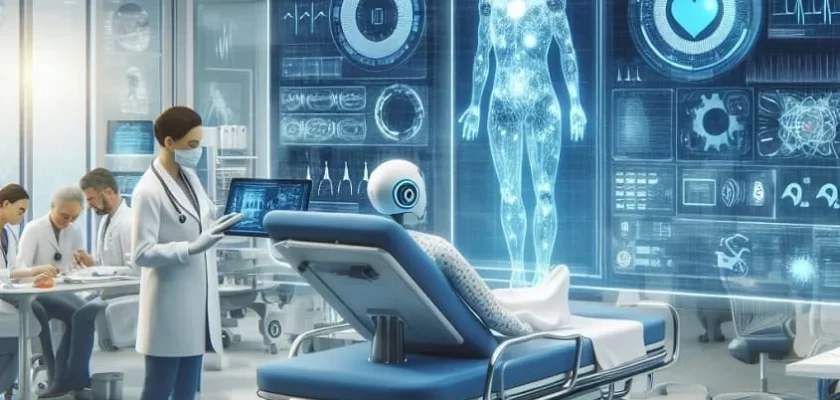The Potential for Artificial Intelligence in Healthcare
- Posted on August 31, 2022
- By Happy Kumari
- Read 4 minutes

In recent years, there has been a greater emphasis on the application of artificial intelligence (AI) in business and society to solve complex problems. Similarly, the use of artificial intelligence (AI) in healthcare is increasing, while radically altering the face of healthcare delivery. Artificial intelligence is being used in a variety of settings, including hospitals, clinical laboratories, and research facilities. AI approaches that use machines to sense and comprehend data in the same way that humans do have opened up previously unknown or unrecognized opportunities for clinical practitioners and health care organizations.
Artificial intelligence (AI) will be used more frequently in healthcare due to the increasing complexity and volume of data. Several types of AI are already being used by payers and providers of care, as well as life sciences firms. Diagnose and treatment recommendations, patient engagement and adherence, and administrative activities are the most common types of applications. Several research studies have already discovered that AI can perform as well as or better than humans at key healthcare tasks such as disease diagnosis. Algorithms are already outperforming radiologists in detecting malignant tumors and advising researchers on how to build cohorts for expensive clinical trials. However, we believe that it will be many years before AI replaces humans in broad medical process domains for a variety of reasons.
Phases of Scaling AI in Healthcare
We are still in the early stages of understanding AI and its full potential in healthcare, particularly in terms of the impact of AI on personalization. Nonetheless, interviewees and survey respondents conclude that, looking at existing solutions and the pipeline of ideas, we can expect to see three stages of scaling AI in healthcare over time.
Phase 1
First, solutions are likely to focus on the low-hanging fruit of routine, repetitive, and largely administrative tasks that consume a significant amount of time from doctors and nurses, optimizing healthcare operations and increasing adoption. We would also include AI imaging applications in this first phase, which are already in use in specialties such as radiology, pathology, and ophthalmology.
Phase 2
As patients take greater ownership of their care, we anticipate more AI solutions that support the transition from hospital-based to home-based care, such as remote monitoring, AI-powered alerting systems, or virtual assistants, in the second phase. This stage could also see a greater use of NLP solutions in the hospital and at home, as well as increased use of AI in a broader range of specialties, such as oncology, cardiology, or neurology, where advances are already being made. This will necessitate a greater integration of AI into clinical workflows, which will necessitate the active participation of professional bodies and providers. It will also necessitate well-designed and integrated solutions in order to effectively use existing technologies in new contexts. This increase in AI deployment would be driven by a combination of technological advancements (e.g., in deep learning, NLP, connectivity, and so on) as well as cultural change and capability building within organizations.
Phase 3
In the third phase, we can expect to see more AI solutions in clinical practice based on clinical trial evidence, with a greater emphasis on improved and scaled clinical decision-support (CDS) tools in a sector that has learned from previous attempts to introduce such tools into clinical practice and has adapted its mind-set, culture, and skills. Finally, respondents expect AI to be an integral part of the healthcare value chain, from how we learn to how we investigate and deliver care to how we improve population health. Integration of larger data sets across organizations, strong governance to continuously improve data quality, and increased confidence from organizations, practitioners, and patients in both the AI solutions and the ability to manage the associated risks will be critical preconditions for AI to realize its full potential in European healthcare.
AI Clinical Applications Now and in the Future
There are numerous AI applications on the market or in the pipeline that can improve patient care and potentially save lives. Pattern recognition, robotics, and natural language processing, which include speech recognition and translation, are among the applications. Machine learning, defined as a “technique that trains software algorithms to learn from and act on new data in order to continuously improve performance,” is also becoming more popular today.
Here are some of the most recent tools that use AI and its subsets to augment various areas of medicine and healthcare, such as:
Caption Guidance
The Food and Drug Administration has just approved this AI-powered software, which can assist medical professionals in capturing acceptable diagnostic quality echocardiographic images of a patient’s heart without any specialized training. Machine Learning teaches software to recognize high-quality 2D ultrasound images of the heart and even record video clips of them, revolutionizing the way heart disease is diagnosed.
MelaFind
This technology evaluates pigmented lesions using infrared light. Dermatologists can use algorithms to analyze irregular moles and diagnose serious skin cancers such as melanoma. Although this technology should not be used in place of a biopsy, it can aid in early identification.
Virtual Assistants
This AI-powered technology can assist people suffering from Alzheimer’s disease in their daily activities. For example, 59-year-old Brian Leblanc began using Alexa on his Amazon Echo Dot for reminders to eat, bathe, and take medication after being diagnosed with early-onset Alzheimer’s disease in 2014. It allows him to have greater control over his life.
Assisted Robotic Therapy
Bionik Laboratories in Toronto and Watertown, Massachusetts, use robotics and artificial intelligence to help stroke patients recover. A robotic arm and hand use digital algorithms to detect and guide patients through motions that they are unable to perform during therapy. It can assist patients in performing more recorded movements per hour than they would with a physical therapist alone.
